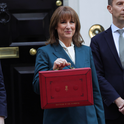The US dollar is the grease that lubricates the wheels of globalisation. In this much, at least, close observers of the world economy agree. Importers and exporters need a universally-accepted means of payment in which to conduct their transactions. Investors need a vehicle with which to pay for their acquisition of foreign factories and financial assets. Central banks need a form in which to hold their reserves. Official and private users need to be sure that their counterparties, wherever they are located, will accept payment in the proffered form.
And in 2017, the dominant such form is the US dollar.
Indeed, despite the fact that the global financial crisis of 2007-8 originated in the United States, the share of dollars in the foreign exchange reserves of central banks and governments hardly budged, as my coauthors and I show in a new book. The greenback remains the main currency traded in foreign exchange markets. It is still the unit in which petroleum is priced, notwithstanding the complaints of Venezuelan leaders.
But this observation points to a contradiction at the heart of the 21st century globalisation. Back in 1960, a decade and a half after the conclusion of World War II, the US accounted for 40 per cent of the global economy, creating a logic for widespread international use of the dollar. But with the recovery of Europe and the growth of emerging markets, the US share of global GDP has declined. Today, following two decades of Chinese super-growth, the US share of global GDP is barely half that of 50 years ago.
The idea that emerging markets, currently experiencing a juvenile growth spurt, will grow faster than the mature economies implies that the US share of global economic activity will continue to fall. By implication, America won’t be able to provide the safe, liquid and universally-accepted means of payment needed to support global transactions indefinitely, and all on its own.
“Alarmists argue that there is no way out: currently, the dollar is no longer capable, while the Chinese renminbi is not yet ready”Moreover, as foreign holdings of US treasury bonds and bank accounts come to exceed the capacity of Washington, DC to raise tax revenues and service its debts, confidence in claims on the US government will diminish. There will then be flight from the dollar, a dearth of international liquidity, and the collapse of cross-border investment and trade.
Alarmists argue that there is no way out, since only one currency can play this global role at any point in time. Currently, the dollar is no longer capable, while the Chinese renminbi is not yet ready. These alarmists invoke the disastrous 1930s, when sterling was in decline but the US dollar was not yet widely accepted, as a cautionary tale.
But, as my coauthors and I show in our book, the truly anomalous period was, in fact, the second half of the 20th century, when, for historically unique reasons, only the US had deep and liquid financial markets open to the rest of the world. In other periods extending back to the 19th century, in contrast, this international function was provided by not one but a number of national currencies. The premise that international currency status is a winner-take-all-game is belied by historical experience.
This revisionist view provides at least some reassurance about the future of globalisation. It suggests that the international liquidity needed to grease the wheels of global commerce can be provided collectively by the US, the Euro Area, smaller countries like Switzerland, and ultimately emerging powers like China.
What about the International Monetary Fund’s accounting unit, Special Drawing Rights? In order to be widely accepted, currencies require a strong government standing behind them. But there is no global government standing behind the SDR.
“The Fed will have competitors—and for those concerned about the future of globalisation, that competition will be a good thing”And what of private-label currencies like Bitcoin, secured by Blockchain rather than governments, an innovation that some observers suggest will push the dollar off its global pedestal? Cryptocurrencies may be secure (“may” is the operative word here). But, questions of security notwithstanding, they hardly display the liquidity and stability required for a unit to become widely accepted as a store of value for banks, firms and governments engaged in cross-border transactions.
Moreover, cryptocurrencies can be used for money laundering, tax evasion and terrorist finance. This creates a high likelihood that governments will ultimately regulate them out of existence.
This is not to say that central banks will refuse to issue digital currencies themselves. Sweden’s central bank, for example, is actively contemplating replacing cash with digital currency. But even in this scenario, the monopoly of central banks over currency issuance—in this case e-currency issuance—will remain.
It follows that 21st century globalisation will continue to rely, for better or worse, on central bank monies, including that issued by the US Federal Reserve. The only difference is that the Fed will have competitors. And for those concerned about the future of globalisation, that competition will be a good thing.
Barry Eichengreen is co-author, with Arnaud Mehl and Livia Chiu, of "How Global Currencies Work: Past, Present, and Future" (Princeton)













